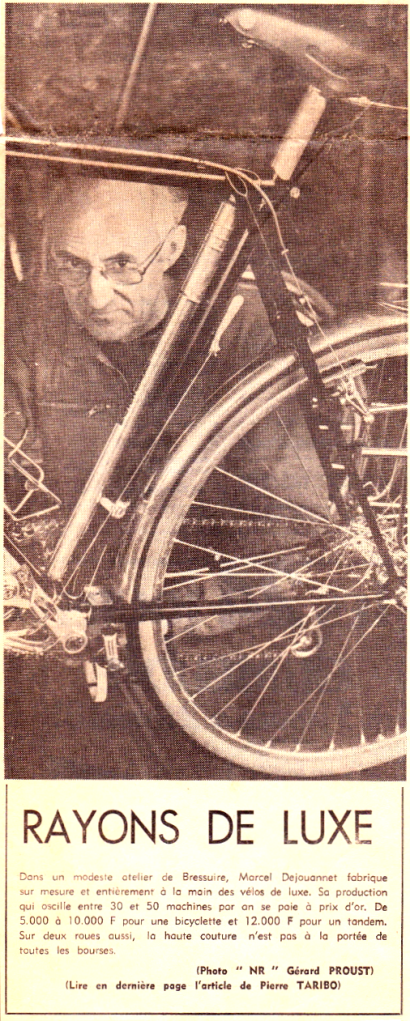Some time ago I found a wonderful and very moving film of Yves Montand singing ‘A Bicyclette’ In the lyric of this song he recalls childhood memories of cycling with friends, and their crush on Paulette, the daughter of the postman. The song is a moving recollection of the romance of a more innocent ‘golden age’ when simple pleasures were paramount and the bicycle was a catalyst for such pleasures. Times have changed but perhaps our interest in the things of the past, such as our passion for vintage bicycles, has much to do with such recollections of golden days gone by, and the stories that our bicycles have to tell. When researching the constructuer Dejouannet, I was delighted to see this song quoted in a newspaper article about Marcel Dejouannet dated 1981, the year of Montand’s performance at Olympia in Paris, referenced above.
The recent acquisition of a Dejouannet Randonneuse of the early 1950’s led me to research this very fine, but little known French ‘constructeur’.
Martial Dejouannet (d.1992) started making bicycles in Paris in the early 1940’s, and his son Marcel Dejouannet (1922-2007) joined him in 1946 to form Dejouannet Père et Fils. Father and son were both members of the Versailles Cycling Club, and Marcel was apparently a reasonable amateur racer.
Little is known about the early history of the Company and few bicycles from the early years seem to have survived. In 1959 Father and Son moved to a shop in the Place St-Jacques in Bressuire, a town in the mid west of France, in the Poitou-Charentes region. They took over the premises of an old bicycle racer, Charles Lacquehay, along with a concession for the increasingly popular Velo-Solex moped. Most of the finest bicycle makers were situated in either Paris or the Lyon/St.Etienne area, so Dejouannet was a little away from the epicentres of cycling activities but apparently grew a clientele of enthusiasts who appreciated the finer points of a quality maker of ‘made to measure’ artisan cycles.
Marcel Dejouannet’s daughter Claudine recalls that, when she was 13, her Father made a bicycle for her which had 650B wheels. The wheels were unusual in having 24 spokes arranged in groups of three, as he said this would make for a stiffer wheel. Marcel had a strict regime of exercise and diet, and in latter years followed the Taoist teachings of Stephen T.Chang, in particular the ‘Internal Exercises’ from Chang’s book ‘The Complete System of Self Healing: Internal Exercises.’ He exercised for about two hours each day. Claudine says that on a bicycle he was inexhaustible!
The majority of the archive material, such as the newspaper cuttings below, relates to the late 1970’s and early 1980’s. At this time Dejouannet was producing between 30 and 50 bicycles per year from their modest workshop in the town. Each bicycle took about 8 days to produce, and there was a waiting list of between 4 and 6 months. The articles stress the expense of the bicycles which in the late 1970’s were priced at between 7000 and 10000 Francs for a bicycle and around 12000 Frances for a tandem – Approximately 3200 to 4500 Euro, and 5500 Euro respectively by today’s standards. This prompted one journalist to remark that ‘Haute Couture’ is available on two wheels but is not within the range of everyone’s purse.’ Marcel responds that it’s not expensive in terms of satisfying a passion.
Martial and Marcel Dejouannet in the workshop in Bressuire in 1981, aged 84 and 59 respectively. Courtesy Mme F. and Mme C. Dejouannet
The titles of the articles are evocative – ‘Rayons de Luxe’ and ‘Le Couturier du Cycle’, the latter a term often applied to René Herse. Marcel said that he was reluctant to expand the business by taking on new employees, as his customers feel more confident in knowing that the boss is making the bicycle. Anyway, he says, even if he had the time to take on an apprentice ( which he didn’t ), the skills are lost and young people are not interested in such a profession. Above all anyone involved with the profession should have a passion for cycling and all that surrounds it. His customers, whether they be from Lille or Marseille were loyal, often returning to him for another machine, whilst one Charentaise family he equipped with bicycles for the whole family, including the 3 children. Another went cycle camping to Cap du Nord in Southern Africa, and three machines were sent to the United States. He says that making a bicycle takes patience, good tools, and a lot of elbow grease. It is working with the hands that gives flavour to life, he says, quoting Michelangelo.
A fine example of a Dejouannet of this period is seen below, a long distance touring machine with substantial racks made by the constructeur.
It is interesting to note the bracing of the rear rack including a strut to the Mafac brake mount, making for a very sturdy platform for luggage. It is built from Reynolds 531 tubing and is fitted with top quality French equipment of the period including Maxicar hubs, Mafac brakes, Stronglight chainset and Huret gearing.
Another example is a chrome plated machine from 1982, featuring internal cable routing for the rear brake, and also wiring for the front lighting passing through the tubes of the rack. This machine was clearly made for lighter touring than the previous bicycle, having a removable rear rack and front pannier supports for shorter distance work.
I would be grateful to hear from anyone with a Dejouannet bicycle or other historical information regarding the marque. This article is evolving and I would like to add to it as new information becomes available.
I am very grateful to Mme.Françoise and Mme.Claudine Dejouannet, Marcel’s daughters, for the archive information, and to Claude Macé and Löic Chauvin for the photographs of their lovely machines











You must be logged in to post a comment.